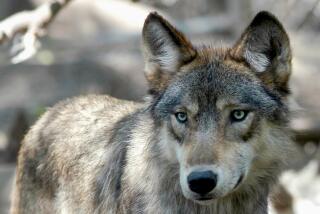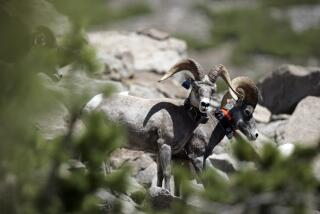Dinosaur may have migrated seasonally
North American dinosaurs may have migrated well over a hundred miles with the seasons, scientists have discovered after a close look at the ancient reptiles’ teeth.
A team led by Henry C. Fricke, a geochemist at Colorado College in Colorado Springs, studied the tooth enamel of Camarasaurus, a long-necked vegetarian sauropod that was common in western North America during the late Jurassic period, about 150 million years ago.
The animals, which were up to 50 feet long, would have had to eat constantly to sustain their large size, and some dinosaur researchers had suspected that they would have had to migrate to find sufficient food and water, Fricke said. But evidence for that had been lacking.
Fricke and two former students, Justin Hencecroth and Marie E. Hoerner, drilled into 32 fossilized teeth found at Dinosaur National Monument in Utah and Thermopolis, Wyo. They compared the ratios of oxygen isotopes within the enamel to that of soil samples near where the teeth were found.
The isotope ratios in the enamel should match that of the vegetation eaten by the dinosaurs — which, in turn, would match that of the soil it had grown in.
The scientists found that the ratios of the isotopes oxygen-16, found in highlands, and the slightly heavier oxygen-18 from the lowlands varied from layer to layer in the tooth enamel, indicating that the source of the vegetation and water had varied at different times of the teeth’s — and the dinosaur’s — growth.
The findings, published in the journal Nature, indicated that the dinosaurs had roamed within about a 185-mile range from the site where the fossils were found, Fricke said.
Though the findings do suggest that the dinosaurs traveled somewhere, it doesn’t specify for how long, or how often. That’s because the teeth had taken less than five months to grow, permitting only a five-month period in the animal’s life to be examined.
Luis Chiappe, director of the Dinosaur Institute at the Natural History Museum of Los Angeles County, said the findings, though intriguing, might not be enough to prove that camarasaurs underwent formal migrations.
“It doesn’t necessarily mean they moved in gigantic herds like on the Discovery Channel or NatGeo showing wildebeests or caribous migrating in herds,” he said.
A trek of up to 185 miles for food isn’t very significant for such a large animal, he said, and the isotopic variations in the teeth could easily mean the reptiles moved in a more casual way between the highlands in warmer months and lowlands during the wet season, following the food.
But Fricke said migrations would make sense.
“Camarasaurs had to obtain their big size fast. We’re assuming they were constantly eating. … They would probably have had to move in some way to keep getting trees that still had leaves on them.”
dalina.castellanos@latimes.com






